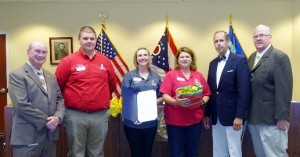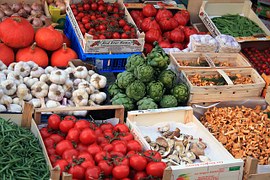Spring greens, onions, strawberries, and more! With the arrival of June, it’s officially farmers’ market season in Northeast Ohio and Ohio State University (OSU) Extension Cuyahoga County is gearing up for another season of offering Produce Perks at local farmers’ markets.
The Produce Perks program offers Supplemental Nutrition Assistance Program (SNAP) customers a dollar-for-dollar match, doubling their purchasing power at participating farmers’ markets, farm stands, CSAs, and mobile markets. For every dollar a SNAP customer spends at a participating farmers’ market or farm stand using an Ohio Direction Card, they receive a free additional dollar, referred to as a “Produce Perk,” to use to purchase fresh fruits and vegetables. Produce Perks allows low-income customers the opportunity to purchase more healthy, locally-grown produce.
 The Produce Perks program was piloted in Cuyahoga County in 2010 by the Cleveland-Cuyahoga County Food Policy Coalition and is implemented locally by OSU Extension. Produce Perks is now Ohio’s statewide nutrition incentive program, guided by the Ohio Nutrition Incentive Network (OH-NIN).
The Produce Perks program was piloted in Cuyahoga County in 2010 by the Cleveland-Cuyahoga County Food Policy Coalition and is implemented locally by OSU Extension. Produce Perks is now Ohio’s statewide nutrition incentive program, guided by the Ohio Nutrition Incentive Network (OH-NIN).
The Ohio Nutrition Incentive Network
Prior to 2015, regions across Ohio operated independent nutrition incentive programs. In 2015, Wholesome Wave, a national non-profit, received a USDA-FINI grant to build the capacity of nutrition incentive programming in Ohio (among 19 other states). Over the course of the three years, regional programs came together to form the Ohio Nutrition Incentive Network and to expand and operate one statewide nutrition incentive program, Produce Perks.
OH-NIN is made up of the following organizations:
- Countryside Conservancy
- Farmers Market Association of Toledo
- Farmers Market Management Network
- Ohio Department of Health
- Ohio Grocers Association
- Ohio State University Extension, Cuyahoga County
- Prevention Research Center for Healthy Neighborhoods, Case Western Reserve University
- Produce Perks Midwest
- Wholesome Wave
 The formation of this network has provided many perks (pun intended)! One perk has been increased support for local and statewide marketing through new or expanded partnerships with agencies such as Ohio Department of Jobs and Families Services. In addition, with Support from Wholesome Wave and Ohio Department of Health, Produce Perks Midwest has been able to test innovative marketing tactics to help guide outreach efforts. Scaling up has also provided the benefit of increased funding; most notably, OH-NIN was awarded funding from Ohio Department of Health funding to implement Produce Perks across the state in 2018. To learn more about the statewide program impacts in 2017, click here.
The formation of this network has provided many perks (pun intended)! One perk has been increased support for local and statewide marketing through new or expanded partnerships with agencies such as Ohio Department of Jobs and Families Services. In addition, with Support from Wholesome Wave and Ohio Department of Health, Produce Perks Midwest has been able to test innovative marketing tactics to help guide outreach efforts. Scaling up has also provided the benefit of increased funding; most notably, OH-NIN was awarded funding from Ohio Department of Health funding to implement Produce Perks across the state in 2018. To learn more about the statewide program impacts in 2017, click here.
Increasing the Match
As of May 1st, OH-NIN increased the match offered through the Produce Perks program to $20. This increase has doubled the SNAP incentive match offered in Cuyahoga County in previous years. OSU Extension and participating farmers’ markets in the county are elated; increasing the match was something we’ve wanted to do for years, but the ability to do so only became possible through the formation and success of OH-NIN. Cuyahoga County saw an increase in demand for incentives and fresh produce immediately after increasing the cap on the matching dollars offered. While most of our farmers’ markets don’t open until June, we have three farmers’ markets in the county that are open year round. When comparing data for May of 2017 and May 2018, North Union Farmers’ Market at Shaker Square has seen a 76% increase in SNAP sales and 104% increase in Produce Perks incentive distribution, increasing sales for small to mid-sized farms. We anticipate seeing similar trends at all markets in the County as the season takes off.
How to Join OH-NIN
In 2018, Produce Perks will be offered at 84 farmers’ markets, farm stands, mobile markets, and CSAs in 20 counties across Ohio. The Produce Perks program will also be offered at a select number of grocery retail sites.
OH-NIN is looking to expand its network of participating locations. Any farmers’ markets, farm stands, or CSAs interested in offering Produce Perks can complete an application found here. Ideally, new sites applying to join OH-NIN would be SNAP authorized by the USDA and have accepted SNAP/EBT for a minimum of one year. However, those are not hard requirements and OH-NIN can provide technical assistance for SNAP authorization and accepting EBT.
If your organization is interested in supporting the work of OH-NIN through partnerships, promotion, or advocacy, please send an email to info@produceperks.org
 To learn more about SNAP at farmers’ markets, Produce Perks, and OH-NIN contact Amanda Osborne, County Extension Educator in Cuyahoga County.
To learn more about SNAP at farmers’ markets, Produce Perks, and OH-NIN contact Amanda Osborne, County Extension Educator in Cuyahoga County.
 After a very engaging and successful Ohio Local Foods week in August, there was a variety of interest expressed in pursuing a center for small business owners to collaborate within Clermont County. As envisioned, this center would incorporate an incubator kitchen for cottage foods producers and other locally sourced value-added products to supply a wide variety of market sectors within the agriculture industry of Clermont County. A preliminary working group has been established to facilitate the process. Over the coming weeks the group will research facilities and design after which a larger group of producers and supporters will be convened to expand upon the foundation work and decide on the next steps in this venture.
After a very engaging and successful Ohio Local Foods week in August, there was a variety of interest expressed in pursuing a center for small business owners to collaborate within Clermont County. As envisioned, this center would incorporate an incubator kitchen for cottage foods producers and other locally sourced value-added products to supply a wide variety of market sectors within the agriculture industry of Clermont County. A preliminary working group has been established to facilitate the process. Over the coming weeks the group will research facilities and design after which a larger group of producers and supporters will be convened to expand upon the foundation work and decide on the next steps in this venture. Leadership! It is a basic fundamental need for any organization to perform as a well-balanced machine. We have learned from an earlier developed plan of work that addressing the needs of county elected officials is a necessity. Many of the public officials I met with during the first few months in my position confirmed this need. They have asked for education in leadership development, conducting effective meetings, communicating more effectively, and other key areas. Based upon these conversations, the
Leadership! It is a basic fundamental need for any organization to perform as a well-balanced machine. We have learned from an earlier developed plan of work that addressing the needs of county elected officials is a necessity. Many of the public officials I met with during the first few months in my position confirmed this need. They have asked for education in leadership development, conducting effective meetings, communicating more effectively, and other key areas. Based upon these conversations, the  Through early discussions with townships and villages, many officials and community members have expressed an interest in strategic planning and goal setting for their communities. This has added to the growing excitement of expansion and redevelopment of infrastructure throughout Clermont County, and community-based projects of this nature are currently being planned.
Through early discussions with townships and villages, many officials and community members have expressed an interest in strategic planning and goal setting for their communities. This has added to the growing excitement of expansion and redevelopment of infrastructure throughout Clermont County, and community-based projects of this nature are currently being planned.
 In our ever-changing world, we want the freshest product available with the most economic value. Often, the solution is to meet local producers and buy directly from them. This helps the consumer to not only enjoy local food, but also learn of the economic, nutritional, and social benefits of buying local. Freshness is one of the benefits of Local Foods adding to the experience of the personal connection between growers and producers. According to the 2012 USDA Agricultural Census, Ohio ranks among the top ten states for direct sales to consumers represented by a wide variety of food products. Two resources available in Ohio to aid in the challenge of linking the producer and consumer are:
In our ever-changing world, we want the freshest product available with the most economic value. Often, the solution is to meet local producers and buy directly from them. This helps the consumer to not only enjoy local food, but also learn of the economic, nutritional, and social benefits of buying local. Freshness is one of the benefits of Local Foods adding to the experience of the personal connection between growers and producers. According to the 2012 USDA Agricultural Census, Ohio ranks among the top ten states for direct sales to consumers represented by a wide variety of food products. Two resources available in Ohio to aid in the challenge of linking the producer and consumer are:  Many people are searching for ways to improve their quality of life by eating local food. Consumers now wish to become the producer, not only in the produce sector, but in animal agriculture. This enables the consumer to gain an intimate knowledge of the food source in a hands-on environment. From this there has been an up-turn in economic development strategies to market locally produced foods. Interest groups in many communities aim to increase the accessibility to items for both wholesale and retail customers. These groups are sometimes lacking one essential component… research-based information. OSU Extension is in a position to educate these individuals in raising and growing their own food, as well as in harvesting and storing their food products. This is an excellent opportunity for cross-program collaboration within our system.
Many people are searching for ways to improve their quality of life by eating local food. Consumers now wish to become the producer, not only in the produce sector, but in animal agriculture. This enables the consumer to gain an intimate knowledge of the food source in a hands-on environment. From this there has been an up-turn in economic development strategies to market locally produced foods. Interest groups in many communities aim to increase the accessibility to items for both wholesale and retail customers. These groups are sometimes lacking one essential component… research-based information. OSU Extension is in a position to educate these individuals in raising and growing their own food, as well as in harvesting and storing their food products. This is an excellent opportunity for cross-program collaboration within our system. How do you double consumer purchasing power at your local farmers’ market? Follow the lead of markets in Cleveland, Columbus, and Cincinnati. They have helped SNAP recipients with a free dollar-for-dollar match for every dollar spent (up to $10) using an Ohio Direction Card. In Cuyahoga County, the SNAP incentive program is referred to as Produce Perks, and the additional match provided can be redeemed for fresh fruits and vegetables.
How do you double consumer purchasing power at your local farmers’ market? Follow the lead of markets in Cleveland, Columbus, and Cincinnati. They have helped SNAP recipients with a free dollar-for-dollar match for every dollar spent (up to $10) using an Ohio Direction Card. In Cuyahoga County, the SNAP incentive program is referred to as Produce Perks, and the additional match provided can be redeemed for fresh fruits and vegetables.


 However, progress has been made over the past several decades to improve legislation, policy, practice and attitudes for individuals with disabilities so that they might have better access to integrated and competitive (community) employment. In Ohio, the
However, progress has been made over the past several decades to improve legislation, policy, practice and attitudes for individuals with disabilities so that they might have better access to integrated and competitive (community) employment. In Ohio, the  These thoughts are from two participants of the USDA AFRI funded Food Security Conference hosted by the eXtension Community, Local & Regional Food Systems Community of Practice (CLRFS eCoP) and held in downtown Cleveland, September 29 – October 1, 2014. The conference included 104 Extension educators, researchers and community partners from Land Grant Universities and local non-profit organizations from 23 states. Since 2012, this group has grown to become the fourth largest eCoP among nearly 80 in eXtension’s nationwide system.
These thoughts are from two participants of the USDA AFRI funded Food Security Conference hosted by the eXtension Community, Local & Regional Food Systems Community of Practice (CLRFS eCoP) and held in downtown Cleveland, September 29 – October 1, 2014. The conference included 104 Extension educators, researchers and community partners from Land Grant Universities and local non-profit organizations from 23 states. Since 2012, this group has grown to become the fourth largest eCoP among nearly 80 in eXtension’s nationwide system.